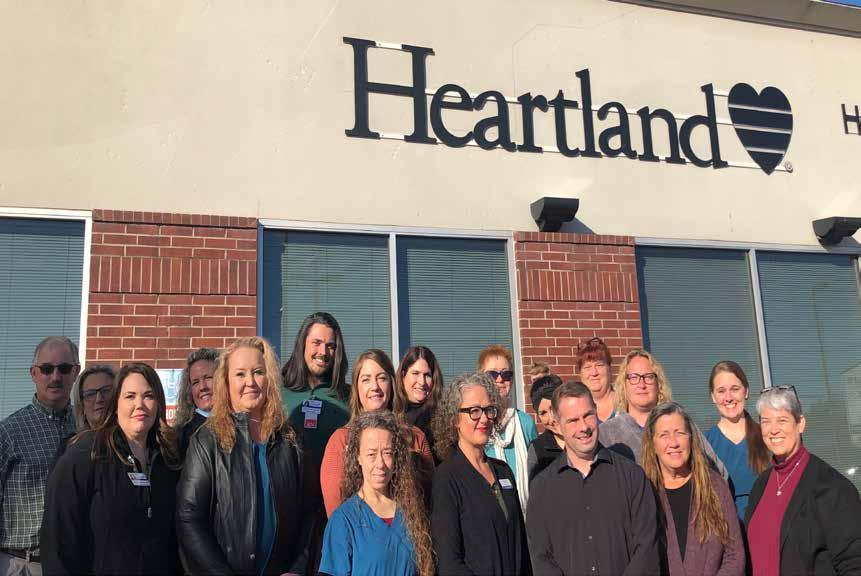






























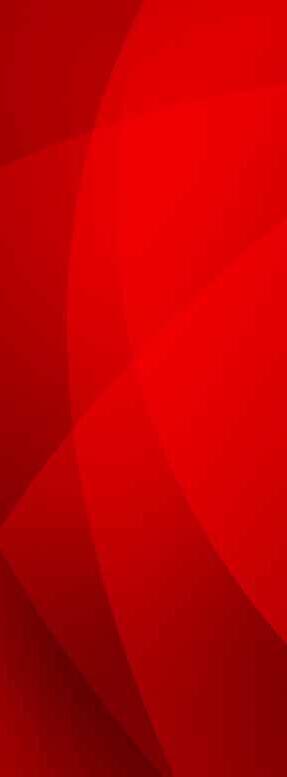








































Astudy by the National Institutes of Health (NIH) identifies the key role hydration is thought to play in the aging process.
aving money can take various forms. It may mean finding the cheapest price, choosing what not to buy or even investing in a higher cost for a lon ger-lasting product. Another aspect to consider is the cost paid by others – the environment, workers and our community. All of these considerations point to the fact that shopping local may, at times, equate to a higher price tag, but one that may be worth the investment.
• Shopping local is often a “greener” option when we factor in delivery trucks as well as packaging materials. These packaging materials create greater waste globally, but also in our home. Disposing of said materials creates piles of opened boxes, packaging and filler materials in our home until we are able to properly dispose of these – costing our own mental energy as we process the clutter.
• Shopping local feeds the local job economy. More individuals in our community will be able to earn a living wage if we choose to frequent local stores for our needs rather than turning to the internet.
• Shopping local serves our community via local taxes – which are often not applied when shopping online – but are a necessary income revenue for our community. When we shop local we feed the economy of our hometown, and if we’re able to do so in small businesses, we’re supporting local business owners rather than big corporations.

• Shopping local also gives us the opportunity to assess what we actually need. If there is a “need” I can’t fill locally, I have the opportunity to consider if it’s worth searching for online or if I can make do without it. It gives us a breath in the buying process rather than feeding the impulse to buy that is often satisfied too quickly online.
Angela Rowland is an OBU graduate and a stay-at-home mother of four. She enjoys finding new ways to stretch the paycheck and share some of her favorite tips and deals.


The research serves as great proof of the importance of drinking enough water to stay properly hydrated. The study determined that when a person’s blood levels show dehydration, they biologically age faster. People are more likely to develop chronic diseases like diabetes, heart failure and dementia and even die prematurely. Decreased hydration levels were actually shown to accelerate the process of biological aging despite age. The results suggested that proper hydration may slow down aging and prolong a disease-free life.
Now the question is how much water we need and how to consume it. The minimum recommendation across the board is at least 64 ounces unless you are put on a fluid restriction by your doctor. The big goal is to slowly work up to half your body weight in ounces of water. For example, a 200-pound person would have a goal of drinking 100 ounces of water.
You have to find what works for you to help you actually get to these goals. Some people like to track their intake on an app, and some people like to use large water bottles with tracking on the bottle itself.
Fruit, herbs and other natural ingredients are great ways to flavor water. Lemons, limes, cucumber, mint and frozen fruit are some of my favorite foods used to flavor water. I have talked about the benefit of water before in this column, but this research serves as a big reinforcement for those recommendations.


I have enjoyed playing around with the air fryer and different vegetables, and they have so far all been hits. Brussels sprouts are a vegetable I have a hard time getting patients to try. Maybe this one will convince you to give them a try. The recipe is pretty easy, and you can have a side dish in 10 minutes.
2 cups Brussels sprouts, sliced lengthwise into ¼ thick pieces
1 Tbsp olive oil
Ingredients: Directions:
1 Tbsp balsamic vinegar ¼ tsp sea salt
In a bowl, toss together the Brussels, oil, vinegar and salt. Cook at 400F for 8-10 minutes, mixing around after 5 minutes.
Makes: 2 servings. Nutritional Information per Serving:
Calories: 164 Total Fat: 7.5g
Saturated Fat: 1g
Cholesterol: omg Sodium: 258.5mg Total Carbohydrates: 21.5g
Dietary Fiber: 8.5g Protein: 7.7g
Nutrition 101: Brussel Sprouts are low in calories but still provide fiber, vitamins and minerals. Brussels sprouts are especially rich in vitamin K, which is necessary for blood clotting and bone health. They are also high in vitamin C, which is an antioxidant that helps promote iron absorption and is involved in our immune function. Research also shows they may reduce inflammation as well. Inflammation is a normal immune response, but chronic inflammation is what can contribute to diseases such as cancer, diabetes and heart disease. For a bonus – check out that amount of fiber above. Remember our goal with every lunch and dinner is to fill half the plate with vegetables. This is just one way to do that.
Andrea Beck, a registered dietitian and personal trainer, received her master’s degree in nutrition and dietetics from the University of Central Oklahoma in Edmond. She offers personal training and nutrition education through an online platform, StrongHER. For inquiries, visit strongherwithandrea.com, or the Facebook page, Nutrition and Exercise 101 with Andrea.


















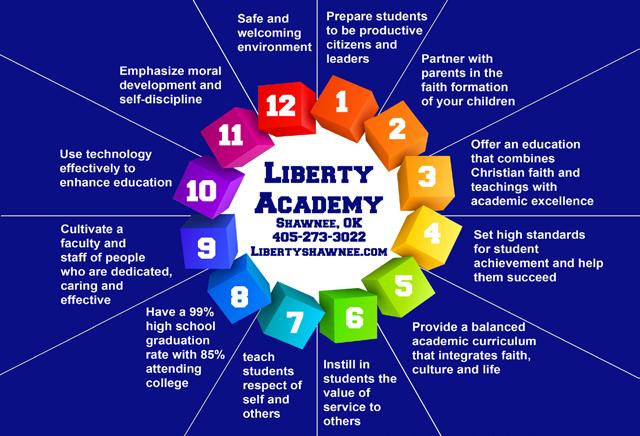









































































































































































































































































































































































































March 20 is the first day of spring according to astronomers, though we are used to celebrating it on March 21.
Are you excited about spring? I am!
Spring is the time of year when flowers and plants start growing again and blooming. The spring – or vernal – equinox means that we have been getting more and more daylight as the winter has continued so that now we will have equal day and night hours. Vernal means new and equinox comes from the Latin that means “equal night.” Daylight will continue getting longer until the summer solstice.
When we think of spring, we think of flowers, or at least I do.
Have you spent time in the Mabee-Gerrer Museum of Art’s courtyard? You can visit our fish and enjoy the flowers and trees. You might even see a squirrel.
Artists have enjoyed painting flowers for thousands of years. How many paintings in the MGMoA have flowers? Have you noticed the irises in the “Reflexion” painting by Bouguereau?

Did you know that flowers can have symbolic meaning? There are meanings like red roses are for love, yellow roses are friendship and pink roses mean admiration or gratitude. There are also meanings of flowers in paintings.
The Virgin Mary is often shown with white lilies that represent purity, but in Roman mythology, the lily came from spilled milk from when Juno was feeding Hercules. The fleur-de-lis – a symbol of France – is a stylized lily. The lily even became the heraldic emblem of the city of Florence, Italy.
Jasmine represents grace, elegance and divine love. You might be most familiar with jasmine as a fragrance in many perfumes. The sunflower – like the ones painted by Vincent Van Gogh – represent devotion.
Artists have
The poppy represents sleep, death and night as well as the Passion of Christ and the Eucharist. The poppy’s connection to sleep comes from Ovid’s description of the realm of sleep being a hidden cave at the end of a field of poppies. The poppy became connected to night, sleep, dreams and even death in the ancient world. In Christian symbolism, the bright red color represents the blood of Christ and is a symbol of the Passion of Christ. Poppies also grow in fields of grain, so there is a connection to bread, which connects the poppy to the bread of the Eucharist. Many people wear a poppy on Remembrance Day (November 11, 2023) to observe the end of World War I and remember those that died. The poppy became the symbol for Remembrance Day due to the poppies growing in No Man’s Land during the war and being memorialized by “In Flanders Fields” written by Lt. Col. John McCrae.
The rose is often considered a symbol of love and was sacred to Venus, the Roman goddess of love. But, also in ancient Rome, the rose had a connection to the cult of the dead with the Rosalia, a celebration of roses. In Christianity, the rose became a symbol of martyrdom due to the thorns.
Spread some color and cheer by painting some brightly colored flowers for your family and friends. If you want a challenge, try creating a 3D flower out of paper.
For more information visit mgmoa.org/artprojects.



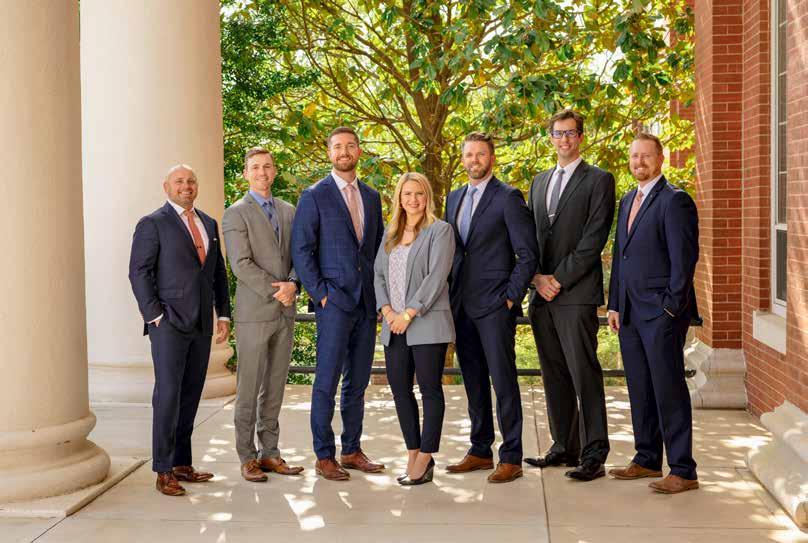



Ashley Fichtner loves to plant a seed and watch it grow.
This doesn’t necessarily mean she’s an avid gardener, but after 16 years teaching nurses at Gordon Cooper Technology Center, she has recently seen some return to where it all began to equip the next generation of health care providers.
"This place did such a great job prepping me to be a really good nurse," said Ashley Miller, practical nursing instructor and alumni at Gordon Cooper.
Coming back to teach felt "surreal" for Miller – who began her time at Gordon Cooper in the Health Careers Certification pathway offered to high school students in the career tech’s district. After further completing the school’s advanced courses to become a licensed practical nurse and later obtaining her bachelor’s
degree from the University of Oklahoma, she worked as a registered nurse before coming back to Gordon Cooper to help students prepare to become practical and effective nurses serving their communities and pursue future career ambitions.
Pathways offered by Gordon Cooper’s health programs are Health Careers at its Seminole campus, Health Careers A and B at its Shawnee campus, Advanced Health and Practical Nursing. They also offer Physical Therapy Assistant and Medical Lab Tech with the partnership of Seminole State College.
The health programs at Gordon Cooper begin for some students at the high school level with the Health Careers Certification program, said Fichtner, registered nurse, Master of Education and the organization’s director of partner school

outreach, Seminole campus and health program administrator. Sophomores in high school can apply to be part of the program during their junior and senior years. Students in the districts served by Gordon Cooper can attend for free, and they can choose to move on to the Advanced Health Careers training for their "13th year" at no cost as well that helps prepare them to pursue further training in the school’s Emergency Medical Services, Licensed Practical Nursing, Medical Lab Technology and Physical Therapy Assistant programs.
Those who follow the adult LPN program undertake 11 months of course and clinical work that focuses on the skills, theory and professional requirements for an entry-level position as a nurse, Fichner said. To ensure students are ready for
their new careers, half of the hours during the course come from clinical experience in healthcare settings locally.
“We depend on and appreciate our partnerships with local clinical sites, hospitals and higher education,” Fichtner said.
Those taking the course come from a variety of experiences, whether it is their first career option or a change in careers, said Lisa Johnson, director of practical nursing at Gordon Cooper. Programs like these create an affordable and comprehensive way to enter health care. The LPN course currently costs a student less than $7,000 to complete, after which they can take the licensing exam and begin working as a nurse.
Some students who enter the field can earn about $50,000$60,000 a year to start, Fichtner said. Others looking to advance further into the administrative aspects of nursing can bridge to a partner university, where they can earn their bachelor's degree and work to become a registered nurse.
Sabrina Fowler – health division technician at Gordon Cooper – said her favorite aspects of working as a nurse came from the practical work she performed with her patients working as a nurse. During her time in the high school program as a student at Gordon Cooper, she thought her instructor's job seemed pretty interesting, but after working as a nurse she was not sure it was something she wanted to pursue because of her love for working with patients. When she discovered Gordon Cooper was adding more hands-on elements to that position, her next step seemed obvious.
“That sounds perfect,” Fowler recalled thinking when she heard the job description for that position.


Fichtner has really enjoyed getting to see former students coming back to Gordon Cooper to shape the next generation of nurses, she said. It's even more appealing knowing the quality of professionalism and experience they bring with them.
"These instructors should all still be in the field because they are fantastic nurses," Fichtner said.
Practical nursing instructor Amanda Carpenter also began her nursing career at Gordon Cooper before taking her skills into the hospice, home health and hospital settings. During the height of the COVID-19 pandemic response, Carpenter was working at the hospital in her rural hometown. Rural facilities like hers did not receive the same kind of support and resources as others during that time, so the staff found itself having to find creative ways to care for their community.
Carpenter found herself "heartbroken” from the pandemic experience and returned for a while to the home health and hospice setting when she heard about the opportunity to teach at Gordon Cooper.

"I always admired my instructors and their hard work,” said Carpenter, who has taken her experience in helping nurses and patients in the field to her students.
In addition to the practical
and affordable aspects of Gordon Cooper’s programs, students also receive access to great resources to coincide with the instruction, Johnson said. For instance, the program offers simulators that mimic adults, children and infants used to create realistic scenarios for nursing students to experience. Instructors can communicate via the simulators and configure them to bleed, sweat, have seizures, need CPR and more so students can practice skills and gain confidence before entering real world health care settings.
Though the practical nursing program at Gordon Cooper takes place during the day, the organization also offers flexible options that can be completed after hours to help students earn credentials like certified nursing assistant, Fichtner said. There are also health programs geared toward students interested working in the fields of veterinary assistant, sports medicine, certified medication aide, medical coding, phlebotomy, Emergency Medical Responder and Unit Secretary.
On top of providing quality instruction for future nurses in the community, those working with the health programs at Gordon Cooper also enjoy the environment it provides to its staff. Several of the instructors spoke fondly of the family-like atmosphere they have with each other in the program.
“We constantly plant seeds and watch them grow,” Fichtner said. “Our staff thoroughly enjoys educating students. For a less than $7,000 investment, (practical nursing) students can obtain a career for a lifetime.”
For more information, call Gordon Cooper Technology Center at (405) 273-7493. S
Philisha Lowe started 6-L Mechanical after husband Zac spent years on unpredictable schedules providing commerciallevel heating, air conditioning, electrical and plumbing services as a way for them to help make their growing family a priority. — Photos submitted


Even 6-L Mechanical’s name implies the importance of family to those behind the business.
Owner Philisha Lowe watched her husband Zac work for a large company in Oklahoma City providing heating, air conditioning, electrical and plumbing services. He attended college to master the necessary skills over the course of six years at Oklahoma State University Institute of Technology in Okmulgee, and he enjoyed the work and the quality of life it provided his growing family. She had been working as a stay-athome during that time as their home welcomed the addition of four children while Zac put in 60-80 hours of work each week.
In January 2016, Zac came off a week
where he had put in nearly 100 hours at his job. In addition to the callouts in the wee small hours of the morning, Zac had also missed daytime family activities with the kids.
“Do you think you could do this for yourself?” Philisha asked her exhausted husband after that grueling stretch.
Zac did not know when he would find the time to figure out how that would work, so she took the reins of establishing a business that would utilize his skills in a way that benefited their family beyond a paycheck.
On April 15, 2016, she started 6-L Mechanical – reflecting the number of Lowes living under their roof at that time – and soon after secured a considerable local account that gave
them a good starting point.
“He gave his two weeks notice, and we took a leap,” Philisha said.
Though she had not been part of the traditional workforce since staying home with their kids, Philisha found that many of the skills she developed and employed while running a household translated to operating a business. On any given day, stay-at-home parents face decisions that involve budgeting, scheduling, prioritizing, training, communicating and more for themselves and others depending on them for their wellbeing.
“I take a lot from how I parented my kids and implement it here,” Philisha said.
And similar to parenting, sometimes partners in a business can disagree on the best course of action to achieve their goals, Philisha said, so the compromises made at home can also translate to a healthy working relationship, especially when operating a business with a spouse.
Zac continued drawing from his years of experience to plan, bid and implement the work while Philisha coordinated, budgeted and operated the business side of 6-L Mechanical. Some of her administrative duties have included clarifying
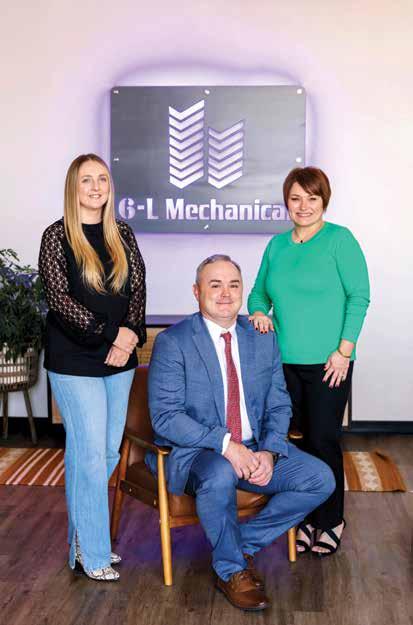
for some what a mechanical company does. Occasionally, Philisha will receive a phone call asking if they work on vehicles to which she must answer that their type of mechanical work focuses on commercial-level heat and air needs, such as boilers, chillers, controls, water treatment, electrical, process piping, welding and other elements of large systems meant to serve larger function than a traditional HVAC unit at most people’s homes – though Zac has helped out folks with those needs when his schedule allows.
In early 2020, the Lowes began looking to move the business to Shawnee where they had some family and where they saw an opportunity for a mechanical company with their focus needed in a growing community. After conducting some research and getting an idea of how they could operate, they took another leap and relocated.
Within a week, the response to COVID-19 pandemic began to slow or stop many aspects of life, and 6-L Mechanical felt the effects. Its largest client was a university, which shut down much of its campus for an extended period of time. This reduced the school’s need for heating and air conditioning services that year, and the Lowes had to pivot. Philisha found herself with less of an administrative focus and put more emphasis on sales and networking than she had to that point.
She got connected to the local business community through groups like Shawnee Forward and made connections personally and professionally that made an uncertain time less daunting.
“It was scary, but it has really worked out,” Philisha said. “What I’ve learned about Shawnee is that it has a very supportive community.”
Not long after their relocation, Shawnee gained recognition at the state level as the top city in Oklahoma for womenowned businesses, and Philisha found herself in the midst of that environment and inspired by that special element of the community.
In addition to growing their business, Philisha found herself growing as a person and business owner as she got more involved in the community. She said her recent graduation from Leadership Shawnee and the connections she formed through that program helped her find a new passion for establishing and building meaningful relationships.
The scale of their business allows the Lowes to do the work they enjoy while also having a schedule that allows them to prioritize the reason behind starting their company – their growing family, Philisha said. As their kids have grown and begun moving out of the house, the business has continued making an impact for the family.
For instance, their daughter-in-law now is able to stay with her four children while also helping earn a paycheck by working from home as the manager for 6-L Mechanical.
“Our foundation has always been family,” Philisha said. “As long as we don’t lose sight of our main focus, then growing the business within our goals is what we want to do. We want to serve our community, serve Shawnee, but always our family comes first.”
For more information, call 6-L Mechanical at (405) 8243558 or visit 6lmechanical.com. S



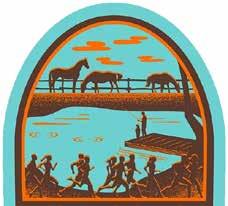









 BY DAVID DINSMORE
BY DAVID DINSMORE
The Shawnee High School girls swim team had a lot to be proud of entering this season as the reigning champions. They also understood the job that needed to be done if they wanted to get back on top of the podium in February.

“We knew we couldn’t slack off,” senior Piper McNeil said. “It’s hard to win the second one. It’s sometimes easier to be the underdog.”
Coach Valarie Colburn and her coaches reiterated that.
“When you’ve won last year, you have a target on your back,” Colburn said. “They knew they had to continue working hard, and I felt that if they were all healthy, they were probably good to go.”
Led by seniors Piper McNeil, Natalie Selman and McKayla Tinkle, the Lady Wolves swim team arrived in mid-February at the Edmond Public Schools Aquatic Center ready to turn all the hard work into a second-consecutive championship, which are determined by points earned by individual and relay groups according to the best final posted times.
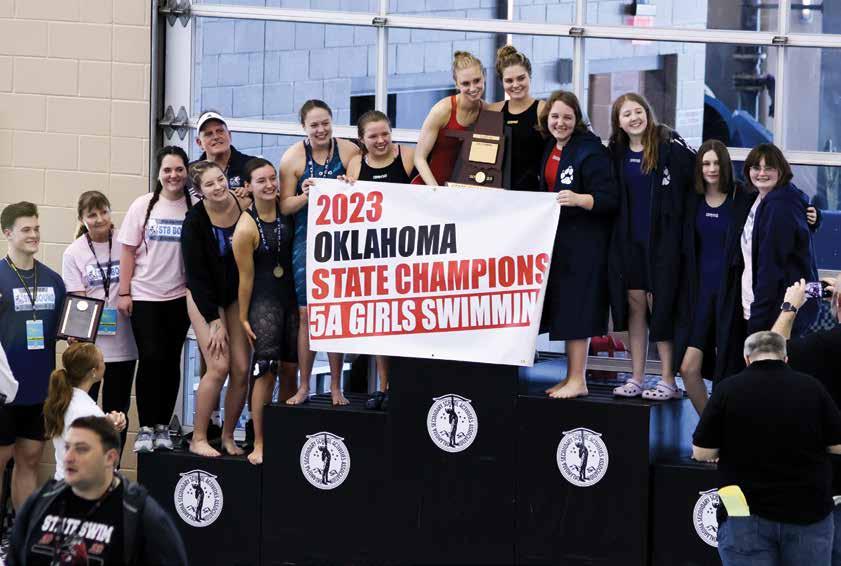
McNeil put her final stamps on the high school books during the meet with state records set in two events. She posted a 51.26-second finish in the 100-yard freestyle and 55.39 seconds in the 100yard backstroke, which she added to a state record she grabbed last year in the 200-yard freestyle.
Selman grabbed a third place finish in the 200-yard freestyle and fourth in the 100-breaststroke, and Tinkle put points on the board for Shawnee by taking sixth in the 100-yard butterfly and ninth in the 100-yard individual medley.
Junior Emma Oller contributed to the overall team championship with two eighth place times in the 200-yard freestyle and the 500-yard freestyle while junior Clara Timmons placed sixth in the 500-yard freestyle and eighth in the 100-
yard butterfly. Sophomores Gracyn Simpson and Ashley McDonald added their performances to the point total. Simpson grabbed second in the 50-yard freestyle and fourth in the 100-yard butterfly, and

McDonald swam to third in the 200yard individual medley and eighth in the 100-yard backstroke.
Freshman Tenielle Kidd made a splash for the Lady Wolves with 10thplace performance in the 200-yard freestyle while fellow freshman Kelly Templeton got her first taste of statelevel competition in the 500-yard freestyle.
McNeil said the relays were a big focus for the team going into the season, and Shawnee won top spot in the 400yard freestyle relay and the 200-yard medley relay finals along with a fourth place finish in the 200-yard freestyle relay.

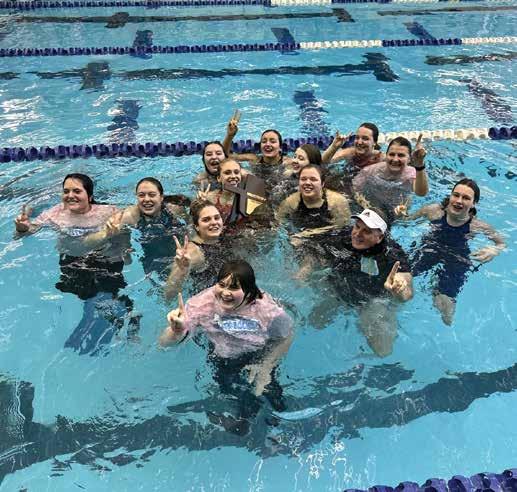
“It couldn’t have gone better,” said McNeil, highlighting the team championship, relay wins and her two state records. “It was honestly a perfect day.”
The team didn’t arrive at the state championship ready to rest on its previous success. The process began as soon as the 2022 championship meet




ended, Colburn said. Unlike many other seasonal sports, swimmers tend to train all year to keep in peak shape and find ways to improve their times long before they climb the starting block.


McNeil said the coaches told them to train as if they hadn’t won it all the previous year, and they often approached practice as if it was a meet.

“It’s fun to race the people in practice,” McNeil said.
The motivation to push themselves during practice also applies to how Colburn selects the competition for the meets in which they compete leading up to the championship, she said. She wants to make sure her teams are swimming against others that will challenge them and want to look for that next gear.
With nine girls qualifying for state, Colburn made sure each girl understood that every performance mattered to the overall team outcome. Whether they made it into the A group or B group coming out of preliminary events, their best effort helped
uted to the overall total.
“It wasn’t about individuals; it was about the team,” said Colburn, making note of the contributions of some of their newest team members. “When the younger swimmers can step up and score us some points, you can’t ask anything more from them.”
With three seniors leaving the team, the performances of the younger swimmers this year pointed toward a continued bright future for the program, McNeil said. She kept in mind her ability to lead by example and offer advice to the swimmers who will carry the team forward after this year.
When she looks back on this year, Colburn said it won’t be seeing those final times or the number of points that will stand out in her mind. It will be the moments in that final huddle with her girls after the announcement they had won their second straight championship and the VIP escort they received from the Shawnee Police Department when they returned to town.
“We told the girls to give our seniors a
“Joe Rawdon is an Advanced Practice Registered Nurse and has served patients living with rheumatic conditions since 2005. He trained and worked directly with a former Medical Director of the Lupus Foundation for 13 years and has been with RAO for the last 4 years. Joe has spoken locally and internationally about the care and management of rheumatic health concerns. He lives in Eastern Oklahoma and is looking forward to serving this area of the state.”
















here are no records explaining how Shawnee was chosen to receive one of the granite drinking fountains distributed by the National Humane Alliance.
What is known is that one was presented to the town even before statehood. The history of the fountains began in 1897 when philanthropist and animal welfare advocate, Hermon Ensign, indicated in his will that a certain amount of his wealth be used to help the public as well as animals.
When he died two years later, the Alliance was in place to build animal drinking fountains for any city that requested one. The fountains were free of charge as long as that city provided an appropriate site, water supply and maintenance. Beginning in 1904, more than 100 cities took advantage of the offer.
The fountains were produced in Vinalhaven, Maine, by the Bodwell Granite Co., the company that supplied the blocks for the Brooklyn Bridge. The fountains were not identical but shared similar designs. The main bowl was for horses and was fed by bronze spigots shaped like lion heads and where humans could also catch a drink.
The lower pedestal had niches on each side with drinking bowls near the ground level for dogs, cats and other small animals. There was a bronze plaque on the side of the upper level with details of the fountain’s construction.
Shawnee got on the list possibly through the efforts of Henry Douglas of Shawnee National Bank who also served as president of the Shawnee Humane Society. When the fountain arrived in May 1907, an article in the local newspaper declared, “This is the only fountain of its kind in the southwest.”
The fountain was delivered on the Rock Island train and was hauled by wagon to North Bell, where it was erected following the council meeting the next night. No payment was required by the town if the requirements by the Alliance were met. One requirement stipulated the fountain be erected on Bell Street between Main and Ninth – considered the heart of downtown – and another qualification stated the city must always supply it with wa-

ter. Even the freight was paid by the Alliance.
It wasn’t long after they were installed that the fountains’ original use became obsolete as motor vehicles replaced horses in the towns. At some point it was understood that Shawnee’s fountain had to be moved to make room for the rush of the trucks and cars, but the community had a nice place for its prized possession. Just a few blocks north of the fountain’s original home, Shawnee leaders had been developing a city park.
There was already a school, the Carnegie Library, sidewalks and various flowers and other greenery at that location. The fountain was moved and was then just for decoration.
It isn’t known when changes were made to the fountain, such as when the plaque was removed. Over the years, some have felt that it might be “stored” somewhere and others fear it may have been stolen, but it has been more than a hundred years since the prized possession was awarded to Shawnee. It was located just west of the Municipal Auditorium in Woodland Park not far from the first cabin erected in Shawnee after the opening of the territory. Over the years, as the use of the park changed, plans were made to protect those historical pieces, and the cabin had been moved to the grounds of Pott County Historical Society Museum. That was the logical new home for the fountain.
It was an exciting moment when the moving day came. Not only would the fountain be displayed at a new home, but a local business offered to “repipe” it so visitors could see it full of water just like it had featured more than 100 years ago. Sadly, when it was carefully moved piece by piece, it was found that some time over the years the “insides” had been filled with cement. Likely, it was felt the fountain would never be used again for its original purpose, and it would be safer to be held together.
But otherwise, it’s there — another artifact from Shawnee’s history — to be seen and be a reminder of early times and “how it was,” and that Shawnee was “on the list” for special treatment.
ommunity is such an interesting word. We all have a definition or thought about what it means to us. When looking up the actual definition so we can all be on the same page during this sort of one-sided conversation. Below is the dictionary definition:
Community: noun, a group of people living in the same place or having a particular characteristic in common; a feeling of fellowship with others, as a result of sharing common attitudes, interests and goals.
Interesting, right?
Shawnee is a community of diversity rich in textures, where you can still find downtown streets paved in brick made for exploring and making memories with family and friends. We have a sense of #ShawneeStrong and quickly band together in moments of natural disasters and celebration. Many of us feel deeply connected, know at least a few of our neighbors and feel like we belong.
What if you didn’t?
According to a previous survey released by Cigna using the University of California-Los Angeles Loneliness Scale, researchers found that 46 percent of Americans report feeling lonely sometimes or always, and 47 percent report feeling left out sometimes or always. A little less – 43 percent – report feeling isolated from others, and the same number report feeling they lack companionship and their relationships lack meaning.
Pause a moment.
Nearly half of our communities are lonely and feel they don’t have somewhere to “plug in,” feel valued or utilize their gifts.
“Having a sense of belonging is a common experience,” Houston-based psychologist Karyn Hall wrote. “Belonging means acceptance as a member or part. Such a simple word for a huge concept. A sense of belonging is a human need, just like the need for food and shelter. Feeling that you belong is most important in seeing value in life and in coping with intensely painful emotions. Some find belonging in a church, some with friends, some with family and some on Twitter or other social media. Some see themselves as connected only to one or two people. Others believe and feel a connection to all people the world over, to humanity. Some struggle to find a sense of belonging, and their loneliness is physically painful for them.”
How do we address this disparaging data here in Shawnee, Oklahoma, and why does it matter?
In a previous local well-being assessment, 55 percent of Shawnee residents understood their purpose, and 53 percent of the respondents reported that they liked what they do every day. So, we know that a little over half of our residents feel connected, and quite possibly the rest of the folks are not sure where they fit for whatever reason.
So now what?
Conditions in the places where people live, learn, work and play affect a wide range of health risks and outcomes and is the wide definition of the social determinants of health, according to the Centers for Disease and Control. When people have access to food, housing, education, feel safe and have nurturing relationships, they are more inclined to make healthier choices.
While you may not directly be able to change access to housing or education, each one of us can utilize our gifts and talents within our community. This utilization has a direct impact on our feeling of fellowship, attitude and feeling of well-being. Using our gifts for the betterment of others has a direct effect on our sense of well-being.
We already possess the power to make our community a kind and inclusive place to live, learn, work and worship. Have you ever helped someone carry their groceries to the car, held the door for a stranger or shook hands at church with a stranger? How did you feel afterward? Maybe you walked away from the experience with a smile or a little pep in your step. Perhaps you felt a little happier. How much effort did that exchange take?
Knowing that people in our community are feeling lonely or disconnected, how can we lift someone today even in the smallest way? We can make eye contact with the mom that is struggling with a small and unhappy child at the grocery store and say, “You’re doing a good job, Mom, hang in there.”
Seeing another person as a person and just smiling can lift you both. Each of us can endeavor to recognize or acknowledge someone this week. Maybe go bigger with giving an hour or more of your time and volunteering with an organization that needs people with your gifts and talents. Yes, it can sound “Pollyanna-ish”, but in the paraphrased words of Gandhi, we must be the change we wish to see in the world.





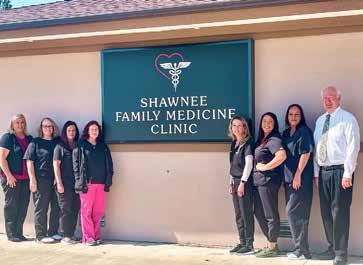
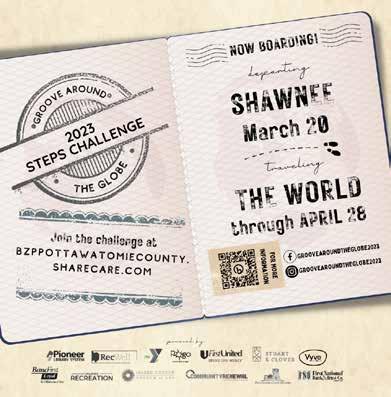



One evening a few weeks ago my wife and I were returning home from a high school basketball game with my two daughters. It was dark and super cold outside as we drove down a small, unlit road just outside of town. Up ahead, I noticed a car with its lights on that appeared to not be moving. As I got closer, the driver flashed the car’s headlights at me a few times. I tapped my brakes and started to slow down, but since it was dark and this was not an ordinary situation, my girls started to get a little nervous. “Dad! What are you doing? This feels so creepy! Please keep driving!”
When I was growing up, this used to be a really normal thing people did. People stopped to ask folks if they needed help. I remember several times when I was young my dad would fire up the tractor at night to pull people out of the ditch when their cars slid off the road in the snow and ice. Heck, I remember us picking up multiple hitchhikers. I’m not sure this was something people did all the time, but it sure seemed to be more frequent than today.
I drove past the car but just didn’t feel right as I looked in the rearview mirror watching the lights get smaller. If the person was stranded, they were going to have to walk a long way in the freezing cold to get help. I just couldn't live with myself if I knew I had the ability to help and chose not to. Naturally, I wanted to protect my family. But from what? I had no reason to believe there was an actual threat., but a thousand scenarios of what danger “might” lie ahead were directed my way as I turned the car around at the next intersection. It wasn’t exactly a popular decision.
There would have been nothing wrong with erring on the side of caution and driving on home. I wouldn’t judge anyone for choosing that option., but I saw this as a learning opportunity for my girls who are growing up in a world where we are overwhelmed with the messaging of fear and danger. You see, I believe the vast majority of human beings are good and decent people. Truly. However, we are far more inclined to be afraid of others these days. There’s a thousand reasons for this. Let’s have coffee sometime and discuss, but there is no doubt that technology, smartphones
and social media in particular are at the center of the conversation.
I stopped our car a good distance from the stranded car with its lights still on. Leaving the car running, I got out and walked toward the car. As I got closer, a woman opened the driver door and got out. She was a little anxious because she was on her way to her evening-shift job when her car died. We walked through all the quick fixes, and I finally decided that she must simply be out of gas. I was going to take my family back home and bring back a gas can when the neighbor across the street walked up with five gallons of gas, which he put in her tank. The car started right up, and she was ready to be on her way again. FIlled with gratitude for two strangers stopping to help her, she thanked us over and over again and offered to pay the gentleman for his gas. He refused of course and simply said that’s what good people do. He was sure she would have an opportunity to help someone else soon and could pay him back that way. We all had a little moment of goodwill and then went about our ways.
Everyone has to decide for themselves what the right thing to do is in moments like that, and again, I’m sure not going to judge a person for choosing to drive on. However, I would like to remind us that most human beings are good folks. Most people want to help others. When we see everyone outside of our circle as a potential threat, we lose a little bit of who we really are. Basic human trust slowly spirals downward and cascading negativity emerges. Fear of threats is built into our DNA and generally is a good thing. It has kept human beings alive for millions of years, but humans are also social beings and thrive in interconnected community. Rather than blindly assuming threat, perhaps we should begin to stretch our trust here and there. Test whether or not human beings really are mostly good. Without a doubt there will be occasions we are let down, and creating boundaries for unhealthy relationships is wise, but life is richer when we try to remain open. May we open our eyes to this possibility and make our world better for ourselves and for others until there is no “them.” There is only us.
March 8-11: The FIRST Robotics Competition Oklahoma Regional will assemble at FireLake Arena at 18145 Rangeline Road.

March 11: The Shawnee Family YMCA will Light Up The Night with its 14th annual Father Daughter Glow Dance 6-8 p.m. at 700 Saratoga with food, dancing and a special gift for every girl. Information: (405) 273-4386
March 11-12: The Community Art Gallery of Shawnee will host its 4th annual Spring Fling art show sponsored by the Shawnee Mall. The show will feature many of the area’s most talented artists of all ages and skill ranges, including local favorites Barbara Nell Steward and Sonya Spears. Information: (405) 432-7676
March 16: The Third Thursday Poetry Reading will start at 7 p.m. dedicated to the memory of Dorothy Alexander – poet, promoter of poets and publisher – who delighted audiences with vivid vignettes of childhood and sharply edged opinions. Poets from the region will read poems dedicated to her, via projected Zoom. In place of open mic, It will be followed by Ben Myers, former poet laureate, reading from his most recent collection, “The Family Book of Martyrs.” Drinks and sweets will be available from the Lunch Box.

March 17: The Arts @317 will host its own Block pARTy on Friday, October 21, from 5:30-8:30 p.m. The featured artist will be Karalisa Duncan, who uses different kinds of mixed media and varying abstract styles to convey her zest for life. Her art comes from a place of healing, and is an outward expression of the lighthearted joy she commits to every day during her battle with cancer.Also on display will be the work of more than 50 other artists. Information: (405) 659-8193
March 17: Iconic classic rock band, Kansas, will carry on with its wayward stop in Shawnee with a show starting at 6 p.m. at the Heart of Oklahoma Expo Center’s Avedis Confer-
ence Center at 1700 W. Independence. This rescheduled show will honor tickets purchased for the original October 2022 date. Information: shawneeexpo.com/events
March 17: VFW Post #1317 Canteen at 811 E MacArthur will host a St. Patrick's Day Bash from 6 p.m. to 12 a.m. with local music, green beer and more fun than you can shake a leprechaun at. Information: (405) 273-7098
March 17: Grab your green and celebrate with the Pottawatomie County Young Professionals at the St. Patty's Party in the Shawnee Forward suite at the Potawatomi Fire game at 7 p.m. at the FireLake Arena at 18145 Rangeline Road for those younger than 40 who work in the county. RSVP required. Information: pcyoungpros.com/rsvp
March 18-19: The Circus Marvelous is coming to town with amazing acrobats, fast-paced jugglers, beautiful aerialists, funny clowns, domestic animals, giant space wheel and much more 4-6 p.m. at the Heart of Oklahoma Exposition Center at 1700 W. Independence. There will be entertainment for the kids on the midway before the performance with camel rides, pony rides, face painting, bounce house and photo opportunities. Information: circusmarvelous.com
March 23-26: The Drama Club Connection will present a theatrical production of “Robin Hood” at the Historic Ritz Theatre at 10 W. Main St. Information: ritzshawnee.org
March 25: Coffee N' Crafts will be hosting an Easter Bunny guided paint at 6 p.m. at 5 E. Main St. Each canvas will be pre-sketched to make it fun for all ages Information: coffee-ncrafts.com
March 25-April 4: Mabee-Gerrer Museum of Art will host its annual High School Juried Art Exhibition for talented artists to display their artwork at the museum. Information: mgmoa.org/high-school-juried-art-exhibit


March 30: Put on your best hat and join the Pioneer Library System Foundation in Wonderland for a A Mad Hatter Tea Party experience at 6:30 p.m. Lakeside Wedding Venue at 33001 Lake Road Reservations are required. Information: plsfdn.org.
April 1: Pottawatomie County & Citizen Potawatomi Nation emergency management teams will bring out the big toys for Touch a Truck and Beyond 10 a.m. to 3 p.m. at Raymond Peltier Park at 1702 S Gordon Cooper Drive Kids of all ages can touch the trucks, ask questions, visit booths and learn all about emergency preparedness in this free familyfriendly event.
April 2: Locomotive Operators of Central Oklahoma will host its monthly public run 1-4 p.m. at 29626 Lake Drive in McLoud. Ride the rails on powered ⅛-scale locomotives right outside of Shawnee Twin Lakes. Information: locotrains.org
April 7: Songwriter Night @ Music Unlimited will feature artist Scott Taylor and other Oklahoma songwriters 7-9 p.m. at 1109 W. Kickapoo Spur St. This live music event is free of charge and open to the public. Information: kevinhall8384@gmail.com
April 8: Community Renewal's Easter Block Party will feature an egg hunt, music, inflatables, free food, face painting, games, prizes 1 p.m. to 3 p.m. at Boy Scout Park at 1400 E Main St. Many local non-profits will also be sharing information. Information: communityrenewal.org/home
April 8: Oklahoma's premier KISS & Van Halen tribute bands, Dressed to Kill and Next Halen, band together for a show at 7:30pm at Historic Ritz Theater at 10 W. Main St. Information: ritzshawnee.com
If you know of any events you would like to see featured, email editor@shawneeoutlook.com. S

